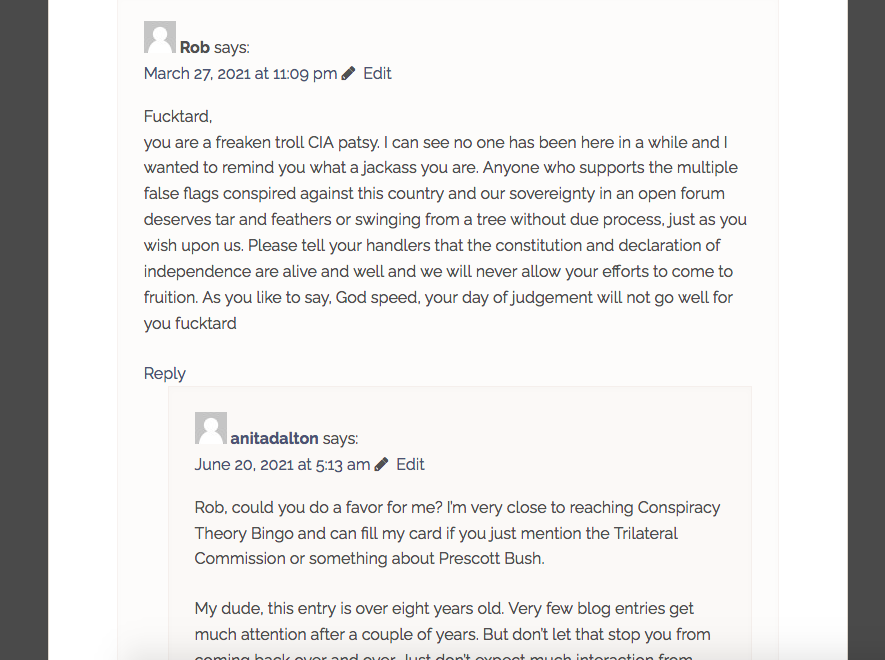This post originally appeared on I Read Odd Books
Before I begin discussing Anders Behring Breivik’s words from 2083, I want to remind any new readers that this is a four-part series. You can read my take on Fjordman’s articles from 2083 in Part One and Part Two.
I am dreading writing about Anders Behring Breivik. Whether I understood it consciously or not, I began discussing Fjordman because he was so much easier to write about. His words, even as they appalled me, were words I knew he thought were true, plus there is the added benefit that he never killed anyone. Fjordman’s passion indicated that he was emotionally connected to his dreadful topics. At no time did I feel like I was reading the whole truth when I was reading Breivik’s own contributions to his manifesto. Many times he read emotionally flat even as he was discussing war and executions.
I don’t think anyone will ever see the real face of Anders Behring Breivik and that is why I dread writing about him. He wears many faces and in so doing, hides his real motives. He is a man who carefully constructed an image before his rampage and is carefully maintaining that image even after his arrest. I can make no assertions that I have nailed Breivik because I am not a psychologist. All I can say is that as a person who has a vast interest in strange ideas and strange people, I have met many people who had or still have ideas I find anathema to a healthy world. Some of these people were friendly, intelligent and affable and their strange beliefs took back stage to the whole of their personality. Some were dark, dangerous people whom I never hope to see or correspond with again. But every one of them was a real person, charming and glib, or earnest and odd, or determined and frightening but there was a core of humanity to them that could not be denied even as I was appalled with elements of their ideologies. Even when I wanted to shake Fjordman, the reason I wanted to shake him was because he is real, someone whose words could create an honest, human reaction.
The same cannot be said of Breivik. Even taking into account the number of articles he reproduced from Fjordman and other Islamophobic writers, there was not much of Breivik present in his manifesto. That sense of no one being at home was not helped by the fact that he often reproduced chunks of text from other writers without attributing it, leading to the impression that those words were his. He outright plagiarized Ted Kaczynski. I swear at times I felt like I was reading slightly repackaged essays from William Lind. Hundreds of pages of Breivik’s interpretation of historical events, political actions and religious beliefs, all as absorbing as entries from supermarket encyclopedias. And about as facile, too. His criticism of political correctness/cultural Marxism showed about as much understanding of the Frankfurt School and reactions to the New Criticism as an answer to a high school essay question. And one assume those high school essayists would know not to crib entire entries from Wikipedia.
All of the plagiarism accusations, all of them correct, popped up after the manifesto was discovered and bloggers ran it through software that detects unfair usage. People seemed jubilant in a manner I could not understand because, on its face, who cares if a mass murderer of children plagiarized his brick of a manifesto? There are far more moral issues to discuss when talking about Breivik. The plagiarism, rather than being one more example of the criminal nature of Breivik needs to be looked at in terms of what it represents. Plagiarism is a form of lying, a form of intellectual theft, and when one steals the ideas of others, it can point to the notion that the plagiarist is trying to either align himself with ideas he thinks are brilliant or he is trying to cover up a lack of confidence in his own writing. I think Breivik’s plagiarism points to both but it also points to something else I will discuss Part Four.
There were moments when Breivik wrote in an extemporaneous, personal style, like in the sections where he reproduced his diary and discussed actions he truly performed. But even when he was talking about himself, he often used trite devices to distance himself from his exposure. It was as if he realized he was talking about himself too much and wanted to distract from it, but couldn’t stop writing about himself even if he tried. For instance, he produces an “interview” called “Interview with a Justiciar Knight Commander of the PCCTS, Knights Templar” and for a few minutes, I thought that maybe, perhaps I was reading the words of a compatriot in Breivik’s scheme. He makes references to having comrades in arms as well as ideology. But no, it was an interview with himself (and whether or not I think the text proves he acted alone is something I will touch on in in depth my fourth article).
When someone who borrows ideology from others, when someone plagiarizes the key points of his manifesto, when he writes as if he has a book open in front of him, yet carries on an interview with himself that goes on for 64 pages, that is a clue of sorts. That clue is that his personality is more important than his ideology. I will later make the assertion that Breivik has a personality disorder, an armchair psychiatric diagnosis to be sure, but for now, Breivik to me is sui generis because he is so bland and so self-absorbed. He is a media-age monster, grooming his image before and after his rampage. It is almost as if how he is perceived is more important than how his actions are perceived, and that will be a key discussion in my part four.
As a woman who knows far more about mass murderers and sociopaths than I ever planned to discover, Breivik is a monster unto himself. He lacks the simmering hatred with a catastrophic trigger that is associated with most mass murderers. For a religious man, who discusses Catholicism as a means of conquering his greatest foes, he talks about it dispassionately and incorporates little of it in his daily life, the Knights Templar cover notwithstanding. In fact, the only time I sensed Breivik was showing emotion was during the first pages of his manifesto when he discusses the utopia he feels like he lost out on because of cultural Marxism, and during some of the discussions of cultural Marxism itself. When he expressed anger in the sections about Islam, the anger very much seemed borrowed from other writers. I sensed none of Fjordman’s urgent paranoia. In fact, I wonder if Fjordman was Breivik’s favorite writer because Fjordman had something Breivik lacks – a passionate identity. Breivik’s utter lack of self outside of his interest in his appearance is remarkable.
Breivik, even in his manifesto, comes across as vain, isolated, and more of a Walter Mitty fantasist than a mass murderer driven by religious bigotry. At times his manifesto read more like an RPG manual, casting a strange light over his use of video games to train. I wonder if, in a narcissistic haze, he saw all of his victims as two-dimensional characters in the self-centered game going on in his head. He comes across more as a man trying on roles – Mason, Knight Templar, Eurabian theorist, chemist, marksman, international criminal and male model – than a man who was driven by hate for Islamic immigration or such deep love for his country he had to protect it at any cost. And there is a reason for those disparities, one all too common.
The reason is that Breivik is a liar. He lies to himself and he lies to us in his manifesto. He hid a key motive for the murders behind hundreds of pages of vaguely relevant information. He isn’t crazy – people with personality disorders can be terribly deluded but they are not insane. He is simply a fabulist, a man who hated the life he was born into and the life he had come to live and was willing to do anything to redefine himself.
Does this mean he was not influenced by Fjordman? Of course he was. I think I made my case for how it is Fjordman’s violent rhetoric influenced Breivik. And in terms of common sense, you don’t reproduce article after article from another writer in your mass murder manifesto unless you are influenced or inspired by them in some way. Even had Breivik never read a word of Fjordman’s work, it still would have been violent, bigoted and misogynistic. It is just Fjordman’s great misfortune that his loaded mini-manifestos found a reader willing to take his words to heart. But I think Fjordman may have influenced Breivik in a way that no one could have anticipated, a way no one can hold Fjordman responsible for. I think Breivik, who already had distaste for Muslims and feminism, found Fjordman so intoxicating because he longed to have the influence that Fjordman had and probably still has.
Fjordman was a part of a tightly knit group of Islamophobes online. People in that oeuvre looked up to Fjordman. They found him to be a great thinker. And Breivik even wanted to meet Fjordman but was rebuffed. I cannot entirely make the case that Breivik had an ideological and sociological crush on Fjordman, but it sure seemed likely when I finished the manifesto. And this is a stretch, but I also wonder how Breivik truly felt about Fjordman refusing to meet him. In his manifesto, he makes little jabs at men who blog and do not act. It is sheer speculation but it has a ring of truth to it that if Breivik could not meet his idol, if he could not become a part of the thinkers who fueled his ideology, he would best him in some manner.
But that’s just one of the theories floating in my head. While Breivik was decidedly an Islamophobe, there definitely other motives that fueled his rampage. The very way he begins his manifesto is a very good clue that he has mixed motives. The beginning is not an overview of atrocities attributed to Muslims, but rather a discourse on how the family of the 1950s cannot exist in a politically correct world. I intend to make the case in Part Four that Breivik was as equally motivated by twisted emotions about what he considers the destruction of his own family as he was the need to end Muslim immigration in Europe. Though in his manifesto he gives a reason for why he did not shoot Muslims, the fact that he shot young people, teens, having fun at a summer camp, speaks to motives in addition to Islamophobia. It is more in line with his loathing of cultural Marxism, but even that only goes so far. By shooting teenagers, he violated even his own outline of the “traitors” who needed to die first. He shot to death dozens of teenagers because he was striking out at a country he felt deprived him of the family and youth he thinks he deserved and missed out on.
So, in my estimation, Breivik is a liar both to himself and his audience, and his motives go further than just a look at his hatred discussed disjointedly and blandly in his manifesto. Given that much of his manifesto is the work of others, either attributed or plagiarized, and that his pages and pages of historical revisionism and examples of Bad Things Muslims Have Done Over The Past 1400 Years are just regurgitated facts from Islamophobia sites, I don’t even see the point of discussing them. Discussing Fjordman’s anti-Muslim beliefs is discussing Breivik’s anti-Muslim beliefs. You can find analysis of those parts of his manifesto elsewhere, and in the comments on those sites you will find refutations that are then refuted and in turn there is more refutation but there is never a conclusion. A True Believer in conspiracy theory cannot change his or her argument and non-believers are foolish even to try and convince them to see reason on an online venue. So I am not going to examine all that minutia and those “facts” repackaged and filtered through Eurabia conspiracy theory. It would just be my facts against their facts and it would be a colossal waste of time.
Instead, I intend to examine this manifesto in two ways. In this article, Part Three, I want to discuss the framework Breivik set up for the massacre and the things he actually did to prepare. I warn you – Part Three is the least interesting part of my analysis and probably reads that way. But it is worth looking at, I think. Breivik may be lying about some of the things he did, but that framework at least seems to have some authenticity to it. The framework, in which he analyzed who should be killed, how to go about it, evasive maneuvers, etc. was clearer and seemed less copied and false than all the facts he vomited up.
There are some out there who seem to think this manifesto should not be discussed at all because parts of it read like The Anarchist Cookbook combined with some volumes from Paladin Press and to discuss it is to aid in the dissemination of such information. I find that laughable at best because there is nothing in this manifesto that the average teenager cannot find in several minutes using a Smart Phone. Moreover, refusing to look at this section because it is deemed too dangerous to discuss just perpetuates the thought that Breivik had to have had help or financial backing, and feeds the fear that there is a sinister group of people training to kill Muslims and liberals in Europe. If nothing else, this manifesto shows what the so-called super-empowered individual can accomplish on his own, which is cold comfort, I know.
All of that having been said, I don’t intend to reproduce any content that could prove a legal liability to this site or to my web hosting service.
In Part Four, which will hopefully come no later than early next week, I will discuss common questions the manifesto answers, Breivik’s emotional motives that fueled the murders, what I consider to be a personality disorder that is evident even to those who did not read 2083, and other inconsistencies and issues that cropped up as I read his “interview” and his diary. That, I think, will be infinitely more interesting than this discussion.
But if you’re still here with me, let’s discuss Anders Behring Breivik.
 Chris is the author of several books, three of which I’ve discussed here. He also produces amazing ‘zines, notably Biblio-Curiosa and Bizarrism. Because the former deals with odd books and the people who write them, I’ve discussed several editions of Biblio-Curiosa on this site, and this week I finally will discuss a couple of editions of his equally delightful Bizarrism. Today, I want to share with you a one-off ‘zine he published, A Day in Rennes-le-Château. Should you want to order any of the ‘zines I discuss here, contact Chris at chris.mikul88@gmail.com.
Chris is the author of several books, three of which I’ve discussed here. He also produces amazing ‘zines, notably Biblio-Curiosa and Bizarrism. Because the former deals with odd books and the people who write them, I’ve discussed several editions of Biblio-Curiosa on this site, and this week I finally will discuss a couple of editions of his equally delightful Bizarrism. Today, I want to share with you a one-off ‘zine he published, A Day in Rennes-le-Château. Should you want to order any of the ‘zines I discuss here, contact Chris at chris.mikul88@gmail.com.
 Mikul goes on to outline various problems in Saunière’s story, softly debunking the story of Jesus’ descendants without being as pedantic about it as I would be had I written this ‘zine. Even so, I find the Merovingian Jesus theory interesting and entertaining, and thoroughly enjoyed reading this ‘zine. Mikul included a “further reading” list, and I’ve read them all. The most entertaining of them all is Rat Scabies and the Holy Grail. Rat Scabies, the former drummer for The Damned, goes to France to hopefully dig up the Holy Grail. He even procured a metal detector for the search. The book caroms from one ridiculous situation to another and you should probably read it.
Mikul goes on to outline various problems in Saunière’s story, softly debunking the story of Jesus’ descendants without being as pedantic about it as I would be had I written this ‘zine. Even so, I find the Merovingian Jesus theory interesting and entertaining, and thoroughly enjoyed reading this ‘zine. Mikul included a “further reading” list, and I’ve read them all. The most entertaining of them all is Rat Scabies and the Holy Grail. Rat Scabies, the former drummer for The Damned, goes to France to hopefully dig up the Holy Grail. He even procured a metal detector for the search. The book caroms from one ridiculous situation to another and you should probably read it.
